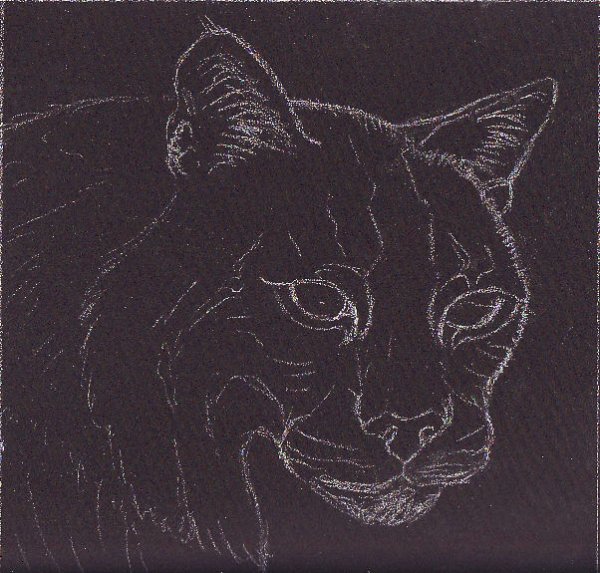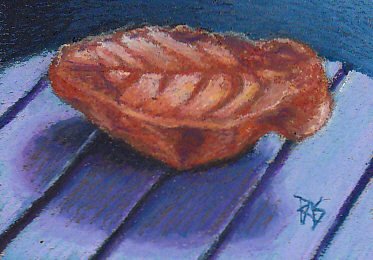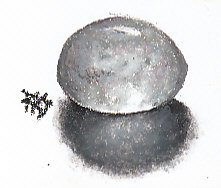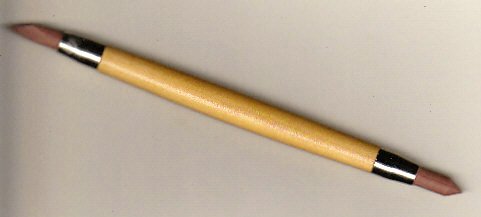|
Tools and Useful StuffTools and other useful stuff that can help you with oil pastels painting will be reviewed here. I'll also add articles on how to use these tools in depth. Most of these things are free or inexpensive, though I suppose if I also use this section to discuss easels and drafting tables that can run into a higher investment of money or time. One oil pastelist friend just built himself a gorgeous oak stained table a lot nicer than anything I've seen in an art supply catalog -- but it takes having a wood shop at home to do that and the knowhow to use it. I'll probably just buy one at Blick when I get around to it, rather than invest in power tools. Meanwhile my working area is a squashy armchair with an easel and some little tables around it. 
Drawing Board My drawing boards are my most important tools when it comes to moving around inside the house and carrying my art stuff. They act as trays, tables, easel display units, photography mounts (when I clip finished art onto the board to photograph it) and large paper storage. This is the cheapest, simplest answer to "What to draw on?" other than improvising one with a chunk of corrugated cardboard. There's a version of this tool you can make for free. Just cut out the shape four times in flat corrugated cardboard, deconstructing mailer boxes from large paper. Glue those together in a stack and paint over it with acrylic varnish. At a fancier version of this tool, there are some parallel edge boards with sliding rulers and drafting tools built in and others that have short feet to set at an angle to turn a kitchen table into a drafting table. I passed on those refinements for the low priced sturdy alternative. I bought two Masonite drawing boards from Dick Blick. Both the large one and the small one are useful for different types of projects. These are big square masonite clipboards with a big heavy clip and a giant rubber band to help hold the paper down. I use the big one for full sheets of Canson paper or half sheet watercolor paper. Until I bought a large portfolio it also served to store large sheets of paper. I'd just put everything oversize on the clip and under the rubber band, then hang it by the cutout handle on a couple of nails on the wall. This one can help you get big flat sheets out of the way and it does allow working large. I use the smaller one much more often as it can handle up to a quarter sheet of watercolor paper. I have no trouble doing 9 x 12" or 11" x 14" art on it and it keeps the art out of the way while it's in progress. Sometimes I stack my drawing board on the easel where it's easy to grab and holds paper firmly, especially if I'm doing a larger piece on relatively thin or floppy paper. Easels A wide variety of easels are available at any art supply company. The price ranges from under $20 to several thousand depending on how elaborate you want to get and how big you want to paint. The biggest most expensive easels are designed for people who do oversize painting on heavy wood panels or stretched canvas -- those giant artworks that wind up in museums. The weight of a wood panel can knock over all but the toughest of those super easels, or even the stretchers on a giant canvas. Some of these fancier easels require tools for assembly. Others don't, either coming preassembled or including any tools you need to assemble them. For oil pastels, a regular easel is fine. I bought a little three pound aluminum field easel on sale at Blick for $30 and love it. I can actually carry that one and it also collapses down to function as a table easel if I want to work vertically at a table. That's my plein air easel. I also have serious disabilities and can't lift more than about ten pounds without doing myself harm. I dreamed for years of getting a French Easel but realized that was not the tool for me since I couldn't even carry it empty. French Easels are the cool wooden sketchbox ones for oil painters or pastelists -- and they are excellent for oil pastelists too. If you do get a French Easel, consider getting the French Mistress or French Companion trays. These are useful tools for spreading out, important for pastelists or oil pastelists. Both are fold-out shelves that sit on top of the sketchbox drawer on a full size French Easel. Price range on French Easels is $69 to $200 or so, with the beautiful aluminum Soltex sketchbox easel coming in at around $500. Once I'm rich and famous I may go for the Soltek because it's sturdy and weighs a lot less than the classic wooden French Easels. One thing to look at between models on those is whether the mast is sunk flush with the top of the sketchbox or sticks out. When it sticks out, it's easier for the wind to catch your painting and bang it around or knock it off. Flush, it's more stable. Everything that's set up for pastelists to use easels will work fine for oil pastels. Many serious oil pastelists use French Easels (the big sketchbox ones) or Pochade Boxes -- these are smaller and designed to sit on a tripod while holding up a small canvas board on the lid. Some of those run a little pricy in the $200-$300 page but they are pretty cool. Pochade boxes are usually large enough depending on how much of a palette you want to bring into the field. If you like having a lot of pastels with you, then getting an extra folding stool to set out a pastels box is probably a good idea. My other easel is one I bought at Blick for about $80, there is a similar model Lyptus easel there now for a similar price. It folds flat for storage, has a big lower shelf, tilts forward for use with soft pastels or completely flat for watercolor. It's become mostly a display area and storage shelf unless I'm doing something very large because I prefer working flat on the drawing board. Other, more abled artists may find an easel is good for their health. If you stand to work at an easel and step back from your painting, you will get a better idea of how it balances. I do that by scanning and looking at the thumbnails in my scanner software. But if you want to be physically active, set the easel to standing height and work vertical. If you take a French Easel out plein air painting, you will definitely get an even better workout as well as the glorious experience of painting from life. There is a reason why so many artists are skinny vigorous people who live into their 80s and 90s without slowing down. I think easels are a big part of that. Tables Drafting tables are usually designed to be taller than normal tables. Artists sit at tall drafting stools or chairs, often with their feet off the ground on the metal ring over the casters or feet. They're that tall so that you can work standing up. Again, walk away from the art to look at it from a distance, go back to add a few strokes and maybe sit down on the stool only while doing a detailed close area. They usually tilt up at an angle, which may make it easier for crumbs to roll down into the pencil groove and off your painting. Work from the top down on a slanted surface like that. Alternately, you can work on a flat table and just use whatever you have in the house. A drafting table isn't necessary but many artists like having art propped up at that angle. You can also get drawing boards that have short feet on the back to put on your kitchen table for the same effect. Taboret A very fancy little cabinet on wheels with drawers and maybe an open cabinet shelf for stacking things. They cost a lot even if they're made out of plastic. They're good for storing small tools and brushes and things that get lost easily. Usually they have casters. So do kitchen islands and carts. I've seen inexpensive rolling kitchen carts the size of taborets with very similar functions at a third of the price. There are also rolling plastic drawer units available in discount stores for about $30 that serve the same function for crafters. So whether you purchase a beautiful expensive actual taboret from an art supply store, build it yourself in your home wood shop or just get the plastic three drawer unit, it's really up to you how much you want to spend on studio furniture vs. art supplies. The range of prices and quality is vast. I tend to focus more on the stuff I can draw with, but I've also seen those plastic drawer units get stained and beaten up over the years too. Figure out what your budget is and how important the look of your studio is. Good furniture is sturdier than the cheap stuff. It lasts for years. If you are already making good money on your art and upgrade to a good taboret, it may be a tremendous convenience. If you're short on cash and would rather spend it on artist grade oil pastels, then the discount store version may be a better alternative. Something small with wheels and a drop spot for open boxes of supplies next to the drafting table is very handy. That's the bottom line on taborets, whether they were originally called that or not. You can also get casters and put them on the legs of a mini-dresser if you find one in a thrift shop.
Skin ProtectionGloves In A Bottle Jerry's Artarama carries this barrier cream. Wash your hands, rub some of this in and let it dry. It will keep toxic pigments from Holbein and Senneliers from migrating into your skin, though if you don't have cuts the risk is much less than it is from inhaling soft pastels dust. The nice thing is that it makes it a lot easier to scrub those staining colors off your skin and it also moisturizes. A little safety and a lot of convenience. Invisible Gloves Blick carries this barrier cream and it serves a similar purpose. This is especially important using Sennelier or Holbein oil pastels but it can also help keep nontoxic staining pigments from staining your skin. So it's either a health aid or a convenience depending on the brand of oil pastels you use.

Holbein Deluxe Pastel Holder
A square metal holder with a sliding band, this tool is good for handling very small pieces and keeping your hands clean while using unwrapped Holbein sticks. I bought one because my Holbein sample kept melting in my hot fingers. I got yellow all over my clothes, my chair and everything including my keyboard when I tried my first sample stick. It's a little cumbersome to stop and change colors but I decided to see if I'd get used to it once I got my set of Holbeins. After doing the Cretaceous Fossil painting in Holbeins, I discovered it was easy for me to keep changing sticks. I slowed down and took my time with that painting. The Holbein Deluxe Pastel Holder did a good job of keeping the toxic pigments off my hands and just keeping the sticky colors off my hands and hence off my clothes, lap, coffee cup, cat, etc. If you like unwrapping your oil pastel sticks as many artists do, Jerry's also carries a variety of other Intus pastel holders in different sizes for different types of pastels and oil pastels. As my sets wear down I may purchase the round ones too, it'll help a lot to get use out of the last little pieces of well-loved colors.
Blending tools
Colour Shapers

Loew-Cornell Paint Eraser This is the poor man's Colour Shaper. If you don't want to invest a lot of money in Royal Sovereign Colour Shapers or extra firm Clay Shapers, you can find this in craft stores and art supply stores for a very reasonable price. It is $4.99 online at Dick Blick art materials where I got mine. The pointed end is shaped a bit like the Taper Point but more shallow with a very sharp point. The longer angled point is close to the shape of the Angle Chisel tip on a Colour Shaper. While the color of the rubber looks like a pink eraser from the end of a pencil but a little darkened, like an old pencil eraser (the sort that will crumble as soon as you put it to paper and streak deep pink on everything), it's actually got a great firm texture close to the Extra Firm Clay Shaper texture. That makes it handy for oil pastelists and for anyone just starting out who doesn't want to experiment with five different shapes of tools before getting just one to see how they like the use of these tools. It's got the two most useful point shapes on one handle and it's so inexpensive it's a good starter tool. It can be used to do sgraffito in oil paint or in soft oil pastels applications, though I haven't tried scraping lines with the points in harder oil pastels yet. All in all, it's a good bargain and a good addition to my toolbox even though I also have the Clay Shapers -- fewer things to keep track of if I toss it in my pocket for plein air work, and it is a little larger than the Size 2 ones I bought. Size of tips is about halfway between Size 2 shapers and Size 6 shapers.
Proportion and Measuring ToolsProspek Proportion Tool
Oil Based Colored PencilsMany serious oil pastelists use oil-based colored pencils for details and edging. I will be testing and reviewing several brands for this purpose, listed below. You don't need a large set for detailing an oil pastels painting. A dozen or two will give enough range for the tiny highlights and edge reworking needed when most of the painting is in oil pastels.
Now if Faber-Castell would just come out with a good artist grade oil pastel in the Polychromos color matching system, I'd be very happy about that. Pester the company, it might help them take an interest.
Unfortunately these pencils have been discontinued. I love my 36 color set, so if you see any at an art store or photography supply shop, snap them up. They are excellent oil based pencils for use with oil pastels but they're no longer available online as far as I know. Unless they turn up on eBay, you never know what discontinued items appear on eBay when someone changes hobbies!
These are unusual and easier to find in camera and photography shops than art stores. Some sets are as small as six, the entire range is 33 but they are expensive in open stock -- about $3 and change per pencil. The same colors are available in tubes and formulated to work well with photograph emulsions. Some oil pastelists really like these for detailing. I haven't tried this method yet but will definitely be testing my Marshall's pencils to compare them with the rest -- these are even more expensive than Caran d'Ache Pablo in open stock, so I will be very curious to see how they handle compared to Lyra Rembrandt and Walnut Hollow. They are probably better for photo alterations, but may have some advantages in oil pastel retouching and edging too.
|





